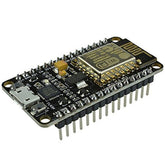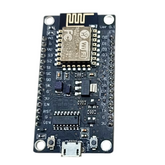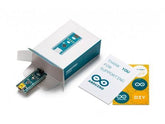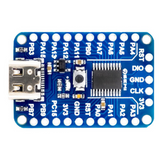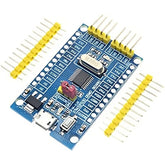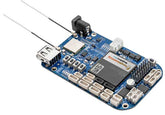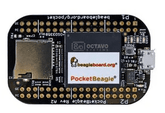How to Become an Embedded Systems Engineer
Summary
The world around us is powered by invisible intelligence, from smartphones to smart homes, from automotive systems to medical devices. Behind these innovations are embedded systems engineers who bridge the gap between hardware and software.
If you're fascinated by how technology works at its core and want to build the next generation of intelligent devices, becoming an embedded systems engineer might be your calling.

What Is Embedded System Engineering?
Embedded system engineering is a field of engineering that focuses on designing, developing, and maintaining computer systems integrated into larger devices. It is different than general-purpose computers. Embedded systems are designed for specific tasks and operate with real-time constraints.
Devices like your smartphone, washing machine, car's anti-lock braking system, and even your smartwatch all run on embedded systems. It’s important to understand that these are not standalone computers, but specialized computing units embedded within larger mechanical or electrical systems.
Following are the 3 main domains that Embedded systems engineering combines:
- Hardware design: Understanding microcontrollers, processors, sensors, and circuit design
- Software development: Writing efficient, low-level code that directly interfaces with hardware
- System integration: Ensuring hardware and software work seamlessly together
Another notable aspect is that embedded engineers often work with kilobytes of memory and limited processing power. This constraint requires you to be innovative and efficient
What Does an Embedded Systems Engineer Do?
The job of an embedded engineer is really complex and the detailed outline of the job varies depending on the company and the sector you decide to work in. However, it might look like the following:

Design and Development
- Conceptualizing circuit boards and microcontrollers or processors
- Writing firmware and hardware-related software in C, C++, or assembly language
- Creating device driver programs that facilitate the interaction between hardware components and software
- Writing applications for real-time operating systems (RTOS)
Testing and Debugging
- Fixing the issues in hardware-software by using tools such as oscilloscopes, logic analyzers, and debugging tools
- Checking the performance of the whole system through tests to be able to confirm the real-time requirements are met
- Also, power consumption, thermal management, and system reliability aspects are checked
Integration and Optimization
- Employing integration methods for sensors, actuators, and communication modules
- Refining the code from the point of view of memory consumption and execution speed
- Ensuring that the device is in line with the industry standards and safety regulations
Documentation and Collaboration
- Preparing technical documentation for system architecture and code
- Interacting with the teams which are not functionally related such as engineering of mechanics, product management, and quality assurance
The job requires intellect but it is very rewarding. In a sense, you're essentially giving life to the products.
Skills Required to Become an Embedded Engineer
Each of two categories of engineers, i.e., embedded hardware engineers and embedded software engineers, need to possess technical skills along with personality traits to be able to reach their career goals.
Technical Skills:
- Programming Languages: In both C and C++, one has to be proficient. It is these programming languages that allow the hardware to be controlled directly, something which is the core of embedded development. Apart from that, a little knowledge of assembly language might be helpful especially in the sections of the code that are oriented towards performance.
- Microcontroller Architecture: The knowledge about the microcontrollers of the families like ARM Cortex, AVR, PIC, and the other ones, their instruction sets, memory architecture, and peripheral interfaces.
- Hardware Knowledge: Should be able to get the idea of digital as well as analog electronics, read the process diagrams, recognize communication protocols (I2C, SPI, UART, CAN) and know the basics of the circuit theory.
- Real-Time Operating Systems: A concept of RTOS, ideas of task scheduling, inter-process communication, and memory management.
- Debugging Skills: JTAG debuggers, in-circuit emulators should be utilized in a skilled manner, at the same time, one should be able to pinpoint the hardware and software faults.
Soft Skills:
- Problem-solving skill: Embedded systems may be the sources of problems that are not solvable by the usual methods and which require inventing new ones.
- Attention to detail: It could be just one wrongly set register value or one misplaced semicolon that is all what it takes for the whole system to fail.
- Patience and persistence: The process of debugging embedded systems is very long, thereby requiring one to be patient.
- Communication skills: By giving examples to other people in a non-technical manner, you help them understand the concepts better.
Educational Qualifications and Courses for Embedded Systems
The path to becoming an embedded systems engineer typically starts with formal education, though self-learning has become increasingly viable.

Academic Foundation:
A bachelor's degree in Electronics Engineering, Computer Science, or Electrical Engineering provides the foundational knowledge. Relevant coursework includes:
- Digital electronics and microprocessors
- Data structures and algorithms
- Computer architecture and organization
- Signal processing
- Control systems
Specialized Courses:
Several embedded systems engineer courses are available both online and offline:
- University Programs: Many universities offer specialized master's programs in embedded systems
- Professional Certifications: Companies like ARM, Texas Instruments, and Intel offer vendor-specific training
- Online Platforms: Coursera, edX, and Udemy provide courses ranging from beginner to advanced levels
- Bootcamps: Intensive training programs focusing on practical embedded development skills
Certifications:
While not mandatory, embedded systems certifications enhance credibility:
- Certified Embedded Systems Engineer (CESE)
- ARM Accredited Engineer (AAE)
- Real-Time and Embedded Systems Specialist Certificate
- Vendor-specific certifications from companies like NXP, Microchip, and STMicroelectronics
The key is balancing theoretical knowledge with hands-on experience. Theory without practice is hollow; practice without theory has limited growth potential.
Tools and Technologies Used in Embedded Development
The embedded systems development ecosystem comprises diverse tools and technologies. Here's what you'll work with:
Development Boards:
- Arduino (beginner-friendly, great for prototyping)
- Raspberry Pi (Linux-based embedded systems)
- STM32 Discovery/Nucleo boards (professional-grade development)
- ESP32 (IoT applications with built-in Wi-Fi/Bluetooth)
- BeagleBone (industrial applications)
Integrated Development Environments (IDEs):
- Keil µVision (ARM-based development)
- IAR Embedded Workbench (professional-grade with excellent optimization)
- Eclipse with embedded plugins
- Platform IO (modern, extensible IDE)
- STM32CubeIDE (STMicroelectronics ecosystem)
Debugging and Analysis Tools:
- JTAG debuggers (J-Link, ST-Link)
- Logic analyzers (Saleae, DSLogic)
- Oscilloscopes (essential for hardware debugging)
- Protocol analyzers (for communication debugging)
Version Control and Collaboration:
- Git for source code management
- Continuous integration tools adapted for embedded systems
Simulation Tools:
- Proteus for circuit simulation
- QEMU for processor emulation
- MATLAB/Simulink for model-based design
Mastering these tools takes time. Start with beginner-friendly platforms like Arduino, then progress to professional-grade tools as your skills develop.
Roadmap to Start a Career in Embedded Systems
To start a career in embedded systems, follow this structured approach:
Phase 1: Foundation Building (3-6 months)
- Learn C programming thoroughly—understand pointers, memory management, and data structures
- Study basic electronics—resistors, capacitors, transistors, and basic circuits
- Get hands-on with Arduino—build simple projects like LED blinkers, temperature sensors
Phase 2: Core Embedded Concepts (6-9 months)
- Deep dive into microcontroller architecture (choose ARM Cortex-M as a starting point)
- Learn about interrupts, timers, ADC/DAC, and communication protocols
- Study RTOS concepts and implement simple multitasking applications
- Build intermediate projects: motor control, sensor interfacing, LCD displays
Phase 3: Advanced Topics (6-12 months)
- Explore embedded systems design principles and best practices
- Learn about power management and optimization techniques
- Study wireless communication (Bluetooth, Wi-Fi, LoRa)
- Understand safety-critical system design for automotive or medical applications
- Build complex projects that showcase your skills
Phase 4: Specialization and Career Launch
- Choose a specialization (IoT, automotive, robotics, medical devices)
- Contribute to open-source embedded projects
- Build a portfolio demonstrating your projects
- Network with professionals through conferences and online communities
- Apply for internships or junior positions
Throughout this journey, consistency matters more than intensity. Dedicate time daily rather than sporadic marathons.
Career Opportunities and Job Roles in Embedded Systems
The embedded engineer career landscape is diverse and growing. Here are prominent roles:
Entry-Level Positions:
- Junior Embedded Software Developer
- Firmware Engineer Trainee
- Hardware Test Engineer
- Technical Support Engineer (Embedded Products)
Mid-Level Roles:
- Embedded Software Engineer: Developing firmware for microcontrollers and processors
- Embedded Hardware Engineer: Designing PCBs and selecting components
- IoT Developer: Building connected devices and cloud integration
- Automotive Embedded Engineer: Working on vehicle control systems
- RTOS Developer: Specializing in real-time system development
Senior-Level Positions:
- Lead Embedded Systems Architect
- Principal Engineer (Embedded Systems)
- Embedded Systems Project Manager
- Technical Consultant
Specialized Domains:
- Medical device development
- Aerospace and defense systems
- Industrial automation
- Consumer electronics
- Telecommunications equipment
The embedded systems engineering jobs market is robust. According to industry reports, the global embedded systems market is expected to grow significantly, driven by IoT, automotive electrification, and smart manufacturing.
Salary and Growth Prospects of an Embedded Systems Engineer in India
Let's talk numbers. The embedded engineer salary in India varies based on experience, skills, location, and company.
- Entry-Level (0-2 years): Fresh graduates can expect ₹3.5-6 lakhs per annum. Companies like Texas Instruments, Robert Bosch, and Tata Elxsi hire entry-level engineers.
- Mid-Level (3-7 years): With proven experience and specialized skills, salaries range from ₹8-15 lakhs per annum. Engineers with expertise in automotive or IoT domains command premium compensation.
- Senior-Level (8+ years): Senior engineers and architects earn ₹18-30 lakhs per annum, potentially higher in product companies or with international exposure.
Factors Affecting Salary:
- Location: Bangalore, Pune, Hyderabad, and Chennai offer higher compensation due to concentration of tech companies
- Domain expertise: Automotive and aerospace domains typically pay more
- Skill set: Proficiency in RTOS, Linux kernel development, and wireless protocols increases market value
- Company type: Product companies generally pay more than service-based companies
Growth Trajectory:
The career growth in embedded systems follows technical and managerial tracks. Technical specialists can become principal engineers or architects, while those interested in leadership can transition to project management or engineering management roles.
What makes this field particularly attractive is job security. Unlike many software domains prone to automation, embedded systems development requires deep hardware-software integration knowledge that's difficult to automate.
Top Industries Hiring Embedded Systems Engineers
Embedded systems engineers are in demand across multiple sectors:
- Automotive Industry: The automotive sector is undergoing massive transformation with electric vehicles, autonomous driving, and connected cars. Companies like Bosch, Continental, Delphi, and Tesla hire extensively. Work involves developing engine control units, infotainment systems, ADAS, and battery management systems.
- Consumer Electronics: Smartphone manufacturers, wearable device companies, and home automation firms constantly need embedded talent. Samsung, Apple, Xiaomi, and numerous startups drive innovation here.
- Industrial Automation: Manufacturing automation, robotics, and industrial IoT create demand for embedded engineers. Companies like Siemens, Schneider Electric, and ABB are major employers.
- Medical Devices: Developing life-saving equipment like pacemakers, insulin pumps, diagnostic devices, and patient monitoring systems requires skilled embedded engineers. Regulatory compliance adds complexity, making expertise valuable.
- Aerospace and Defense: Organizations like ISRO, HAL, DRDO, and private aerospace companies develop sophisticated embedded systems for satellites, missiles, aircraft, and communication systems.
- Telecommunications: Network equipment manufacturers need engineers to develop routers, switches, base stations, and communication devices.
- IoT and Smart Devices: The explosion of IoT creates opportunities in smart home devices, wearables, industrial sensors, and connected infrastructure.
The diversity of industries ensures that you're not locked into one sector. Skills transfer across domains, providing career flexibility.
Tips to Succeed as an Embedded Systems Engineer
Here's practical advice for building a successful career:
- Never Stop Learning: Technology evolves rapidly. New microcontrollers, protocols, and standards emerge constantly. Dedicate time weekly to learning. Follow industry blogs, read datasheets, and experiment with new development boards.
- Build a Strong Portfolio: Employers value demonstrated skills over certificates. Build projects that solve real problems. Document them thoroughly on GitHub. Your portfolio speaks louder than your resume.
- Understand Both Hardware and Software: The best embedded engineers bridge both domains. Don't limit yourself to just coding or just hardware. Understanding the full stack makes you invaluable.
- Master Debugging: Bugs in embedded systems are complex—they could be hardware issues, software bugs, timing problems, or electromagnetic interference. Developing systematic debugging methodologies sets you apart.
- Read Datasheets Thoroughly: Datasheets are your bible in embedded development. Learn to read them carefully. Understanding register-level details prevents countless hours of frustration.
- Join Communities: Engage with communities on Reddit, Stack Overflow, and embedded systems forums. Networking provides learning opportunities and job leads.
- Consider Open Source: Contributing to open-source embedded projects builds skills, visibility, and connections. Projects like Zephyr RTOS, Arduino, and various IoT frameworks welcome contributors.
- Develop Domain Knowledge: Understanding the application domain (automotive, medical, aerospace) makes you more effective. Learn about industry standards, regulatory requirements, and domain-specific challenges.
- Soft Skills Matter: Technical excellence alone isn't sufficient. Develop communication skills, learn to work in teams, and understand project management basics.
- Stay Curious: The best engineers maintain childlike curiosity. Ask "why" and "how" constantly. Disassemble devices to understand how they work. This mindset drives continuous improvement.
Conclusion
Becoming an embedded systems engineer is an excellent career choice for those that want to combine creativity, technical depth, and tangible impact. The field offers diverse opportunities across industries, competitive compensation, and job security.
While the learning curve is steep, systematic approach and persistence pay off. Start with fundamentals, build projects, never stop learning, and stay curious. The world needs more embedded engineers to build the intelligent devices that are shaping our future.



